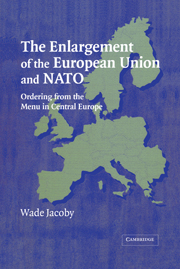Book contents
- Frontmatter
- Contents
- List of Tables, Graph, and Figures
- Preface and Acknowledgments
- Introduction: Ordering from the Menu in Central Europe
- 1 Emulation as Embedded Rationalism
- 2 Emulation as Rapid Modernization: Health Care and Consumer Protection
- 3 Emulation Under Pressure: Regional Policy and Agriculture
- 4 The Struggle for Civilian Control of the Military
- 5 Military Professionalization in War and Peace
- 6 Using Theory to Illuminate the Cases
- 7 Synthesis and Sequence: Juxtaposing Theory Traditions
- 8 Extensions and Conclusions
- Appendix: Selected List of Persons Interviewed
- Works Cited
- Index
Introduction: Ordering from the Menu in Central Europe
Published online by Cambridge University Press: 06 July 2010
- Frontmatter
- Contents
- List of Tables, Graph, and Figures
- Preface and Acknowledgments
- Introduction: Ordering from the Menu in Central Europe
- 1 Emulation as Embedded Rationalism
- 2 Emulation as Rapid Modernization: Health Care and Consumer Protection
- 3 Emulation Under Pressure: Regional Policy and Agriculture
- 4 The Struggle for Civilian Control of the Military
- 5 Military Professionalization in War and Peace
- 6 Using Theory to Illuminate the Cases
- 7 Synthesis and Sequence: Juxtaposing Theory Traditions
- 8 Extensions and Conclusions
- Appendix: Selected List of Persons Interviewed
- Works Cited
- Index
Summary
So when does an idea's time come? The answer lies in the match between idea and moment. An idea's time arrives not simply because the idea is compelling on its own terms, but because opportune political circumstances favor it.
(Lieberman 2002: 709)In 1989–90, the communist regimes of Eastern Europe fell. In a few countries, social movements had challenged and eroded communism; in other places, the regimes seemed to collapse of their own weight. In either case, however, the notion of becoming a normal European state was an idea whose time had come. Almost all the new governments that emerged looked to distance themselves from many communist-era practices and institutions. Elites and citizens generally thought of these changes as part of a “return to Europe.” Even those who argued that one could not “return” to a place (Europe) that one had never left still acknowledged the need for radical changes. Within a few years, elites and citizens also came to a broad consensus that their states should aspire to join the European Union (EU) and the North Atlantic Treaty Organization (NATO), and many subsequent institutional changes were pursued with these goals in mind.
This book analyzes Central and Eastern European (CEE) states' efforts to return to Europe by trying to become members of the EU and NATO. Unlike available accounts of the “dual enlargement,” it pays particular attention to the proclivity of CEE elites to emulate existing institutions from Western Europe.
- Type
- Chapter
- Information
- The Enlargement of the European Union and NATOOrdering from the Menu in Central Europe, pp. 1 - 19Publisher: Cambridge University PressPrint publication year: 2004



